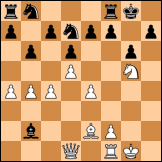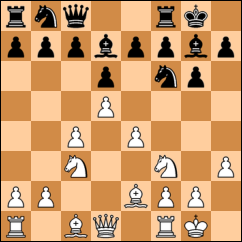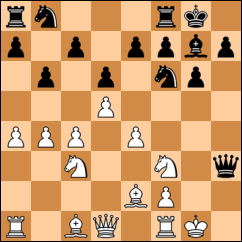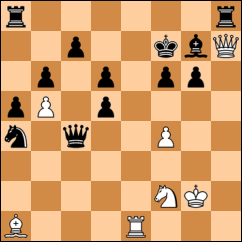A lot of people enjoy chess but are anxious about playing against chess club members because they fear the humiliation of being creamed by some condescending grandmaster. I'm here to tell you, this is not something you need to be afraid of. Beginning in my adolescence, I went on a 27-year hiatus from chess because I couldn't get the hang of it, and I've returned to it only in the past few years with a serious eye toward improving my game. And even though the player I am today would wipe the floor with the player I was just two years ago, I'm still nowhere near as strong as most of the players I encounter at tournaments -- but I can count on my fingers the ones who've been anything but warm, welcoming and helpful.
K.Ammann–S.Black
Route 20 Chess Club
Freeport, Illinois, April 27, 2010
1.d4 Nf6 2.c4 d6 3.Nc3 Be6
This is basically a King's Indian, with one major exception: Steve has just blocked in his e-pawn, so he won't be able to push it to e5. I take aggressive advantage of this stumble.
4.e4 g6 5.Nf3 Bg7 6.Be2 Qe7
Instead of castling. I see an opportunity to trap Steve's light-square bishop and begin to tighten the snare.
7.h3 Qc8 8.d5 Bd7 9.0-0 0-0
Positionally, it's looking nice for me. Nevertheless, I'm facing a dilemma. What I really want to do, somehow, is get my king's knight to e6, but Steve's f-pawn makes that impossible. My consolation, however, is that Steve can't get anywhere on the kingside either. Since I own the center, I figure it's time to push a bit on the queenside.
10.a4 b6
Steve has a better move in 10...Na6, with the idea of 11...c5. (The opposite order is equally effective.)
It's at this point that I make the mistake that will cost me the game. I've been trying hard to train myself to scan for threats before selecting candidate moves, but I still lapse far too frequently. In this case, I miss the fact that, now that I've castled kingside, Steve's queen and light-square bishop are lined up to smash my king's cover. That's not necessarily the best thing for him to do, but the threat is there, and I'm asleep to it.
11.b4??
Not only does this error overlook the breakthrough threat, it also opens up the long diagonal on which Steve has a fianchettoed bishop. If it occurs to him to play 11...Nxe4!, I lose a rook with 12.Nxe4 Bxa1. The move to play is 11.e5 dxe5 12.Nxe5, which retains an advantage.
11...Bxh3 12.gxh3 Qxh3
This actually isn't as bad for me as it looks. I'm up a bishop for two pawns, and Steve's queen has no backup in the attack; in theory, since she has so little room to maneuver, I can just dance around in the corner (e.g., 13...Qg4+ 14.Kh2 Qh5+ 15.Kg2 Qg4+ . . . ) until I get a draw by repetition or Steve backs off and tries something else, giving me time to take cover and/or bring other pieces into the area. With 13.Ra3, the diagonal attack against my rook is disarmed, and I can return to my positional play with a slim but significant material advantage.
But I'm spooked and not thinking clearly. Fully cognizant of what I'm doing, I drop a piece.
13.Ng5 Qxc3 14.Bd2?
It's my best bishop move, if I'm going to move the bishop. But 14.Rb1 is much better -- in fact, it's the only move that may save the game for white. 14...Nfd7 15.Bb2 Qxb2 16.Rxb2 Bxb2  is carnage, but it ends with black only a pawn up, with two undeveloped pieces bottled up in the corner and without any way to attack white's exposed king (right). In contrast, my move lets Steve off the hook with a two-pawn material superiority. It's an imbalance that I won't overcome.
is carnage, but it ends with black only a pawn up, with two undeveloped pieces bottled up in the corner and without any way to attack white's exposed king (right). In contrast, my move lets Steve off the hook with a two-pawn material superiority. It's an imbalance that I won't overcome.
 is carnage, but it ends with black only a pawn up, with two undeveloped pieces bottled up in the corner and without any way to attack white's exposed king (right). In contrast, my move lets Steve off the hook with a two-pawn material superiority. It's an imbalance that I won't overcome.
is carnage, but it ends with black only a pawn up, with two undeveloped pieces bottled up in the corner and without any way to attack white's exposed king (right). In contrast, my move lets Steve off the hook with a two-pawn material superiority. It's an imbalance that I won't overcome.14...Qe5 15.f4
15.Bd3 gives the e4-pawn some needed backup, freeing my knight to counterattack.
15...Qd4+ 16.Kg2 Nxe4 17.Nf3??
Again, I'm overlooking Steve's diagonal attack, this time against my rook, which I mistakenly think is adequately protected (not against his queen and his bishop!). My best bet is to trade knights on e4, then gain time on Steve's queen with 18.Bf3, giving me a chance to rescue my rook.
17...Qxa1 18.Qc2!
Refusing to settle for the obvious. Steve's language begins to get amusingly colorful.
18...Qf6 19.Qxe4 e6 20.Nh2 Nd7 21.Ng4 Qe7 22.Qf3 a5 23.b5
More hilarious expletives from Steve, except in this case, I'm actually better off doing what he expects me to, trading pawns on a5 (I have no reason to fear a rook breakthrough -- my d2-bishop makes that impossible). Moreover, I have a tasty follow-up in 24.Qh3, threatening 25.Nh6+ and 26.Rh1.
24.Bc3?! f6 25.Qh3
It's a nice thought, but I'm pulling needed protection off my e2-bishop, which is under pressure from Steve's queen.
25...Nxa4 26.Ba1 exd5 27.Rh1
Hope chess -- hanging my bishop in order to rush an avoidable attack into action.
27...Qxe2+ 28.Nf2 Qxc4
28...h5 would have shut down my attack entirely.
29.Qxh7+ Kf7 30.Re1 Rh8 0-1
My queen being trapped, I resign here. Surprisingly, however, 30...Rh8 is a bad move compared with the straightforwardly brutal 30...Qxf4. It allows white a tactic that, while not enough to restore equality, will at least leave an attentive player with fighting chances. I didn't see it; can you? (Highlight to reveal answer.)
31.Re7+! Kxe7 32.Qxg7+ Kd8 33.Qxh8+ Kd7 34.Qxa8 Qxb5 35.Bxf6 and white is left with a bishop against five pawns.







0 comments:
Post a Comment